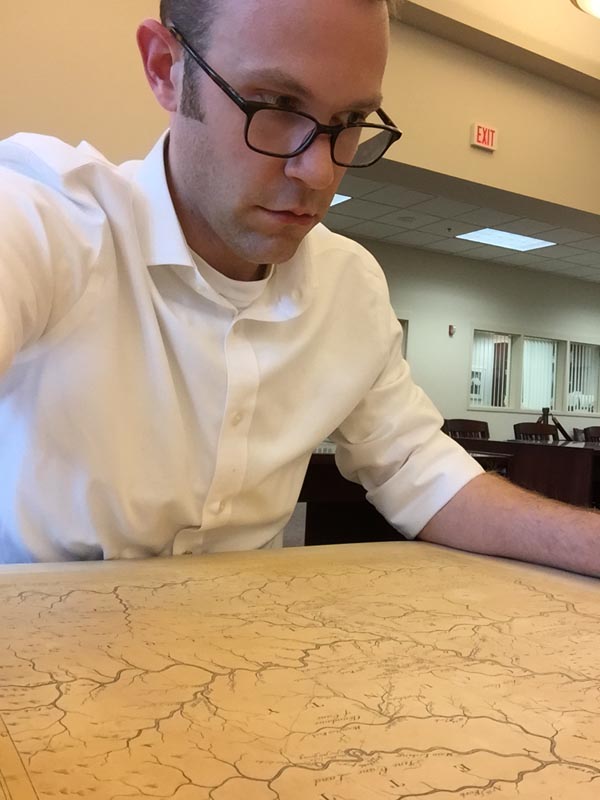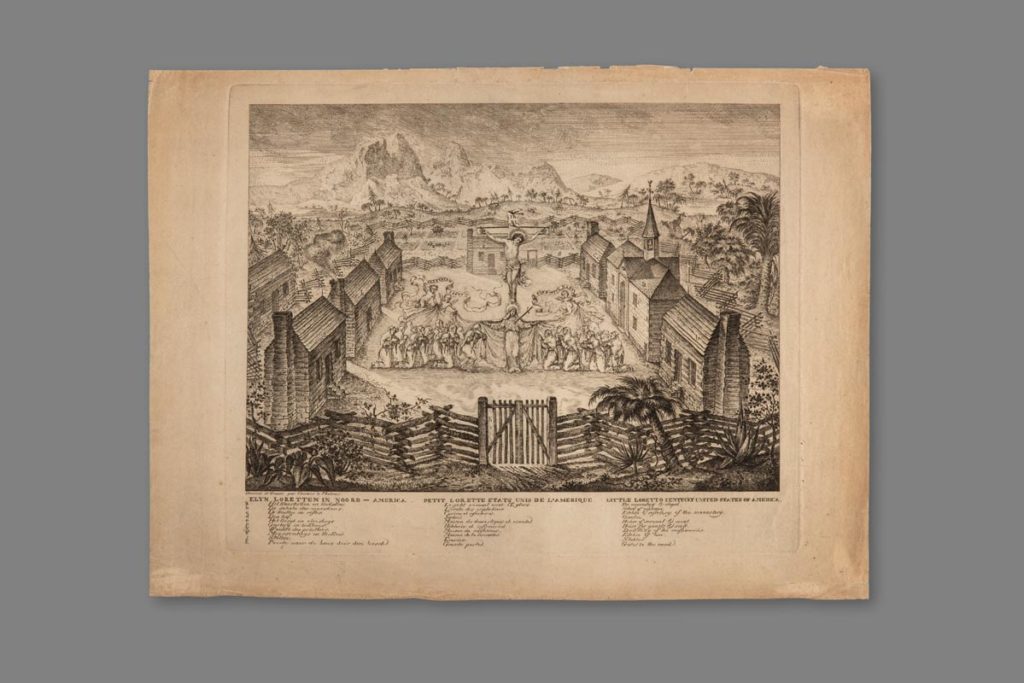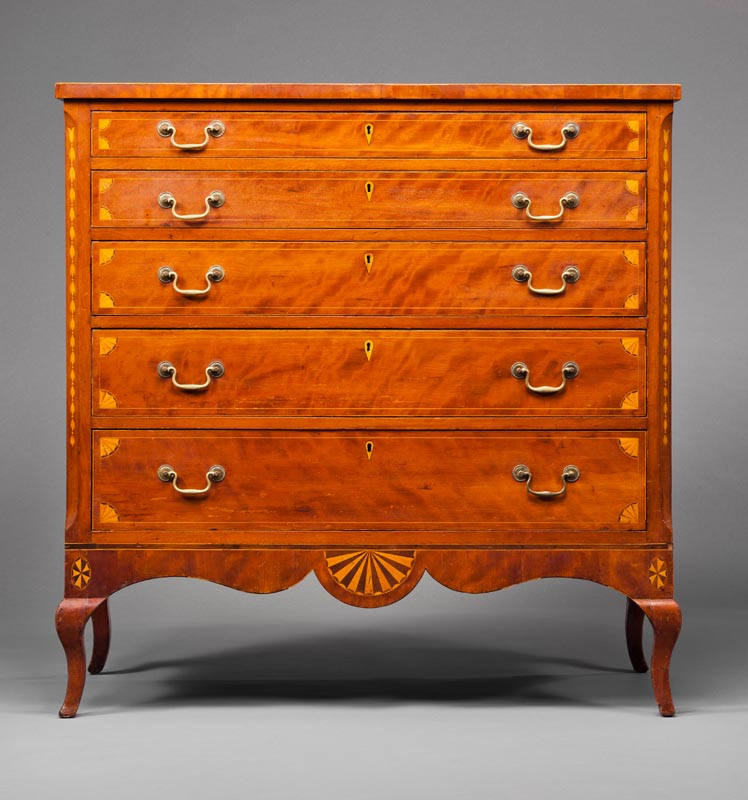SEEKING EARLY KENTUCKY CULTURE
EMERGING SCHOLARS > SUMMER RESEARCH GRANTS
By DANIEL K. ACKERMANN,
Department of Art History, University of North Carolina at Chapel Hill
My dissertation explores Kentucky’s unique geographic, economic, and cultural position between North, South, East, and West using objects. By writing a history of Kentucky using things— a print, a chest of drawers, a house, a silhouette, and a longrifle—I will explore the vital role Kentucky played in forging “these United States” into “a United States.”
When most Americans think about Kentucky three things come to mind: Daniel Boone, whiskey, and horse racing. These recall a Commonwealth founded by intrepid frontiersmen who brought an established Southern culture with them across the Appalachian Mountains. But Kentucky’s early cultural history is much more complicated. I will argue that Kentucky was a not a frontier; rather it was surrounded by diverse communities, including Native American settlements, the former British colonies, and French and Spanish territories.
Thanks to a grant from the Decorative Arts Trust, I was able to survey relevant archives and collections in Kentucky. In Louisville I visited the new Kentucky Gallery at the Speed Art Museum and the Filson Club. The Filson Club holds one of the most extensive archival collections related to Kentucky. I found an 1823 letter from Napoleon’s brother Joseph Bonaparte to Waldemere Mentelle. Two decades earlier Mentelle had sent a booklet of silhouettes to Napoleon depicting the Osage Delegation that visited Lexington in 1804. These little-known portraits remain in France to this day.
In Lexington I visited the University of Kentucky’s Special Collections Research Center and examined a rare copy of The Chaumiere Papers, privately printed in 1883. The Chaumiere Papers recount the story of David Meade, a Tidewater Virginia aristocrat who settled in Jessamine County, KY, in 1796 and built a five-part log house he named Chaumiere des Prairies. Meade’s house is one of the earliest “geometric villas” as described by Clay Lancaster in Architecture of the Bluegrass State. Meade’s house and gardens survive only in period descriptions, architectural drawings, and artistic renderings.
The vertical files at the Kentucky Historical Society in Frankfort are a treasure trove of information, including early-20th-century newspaper clippings about old Kentucky houses and their contents. At several of the archives I was lucky to examine copies of John Filson’s The Discovery, Settlement, and Present State of Kentucke (1784) and the map he published the same year. Filson’s text includes the earliest telling of “the adventures of Colonel (Daniel) Boone.” The subtle changes to Filson’s map and text as it went from Philadelphia, to Paris, to London, will be a topic of exploration in my dissertation.
This preliminary research would not have been possible without the financial support of the Decorative Arts Trust. My summer trip laid a strong foundation for a dissertation aimed to recast the story of early Kentucky as a place where North, South, East and West came together to create a truly American identity in the late 18th and early 19th centuries.
By DANIEL K. ACKERMANN,
Department of Art History, University of North Carolina at Chapel Hill
My dissertation explores Kentucky’s unique geographic, economic, and cultural position between North, South, East, and West using objects. By writing a history of Kentucky using things— a print, a chest of drawers, a house, a silhouette, and a longrifle—I will explore the vital role Kentucky played in forging “these United States” into “a United States.”
When most Americans think about Kentucky three things come to mind: Daniel Boone, whiskey, and horse racing. These recall a Commonwealth founded by intrepid frontiersmen who brought an established Southern culture with them across the Appalachian Mountains. But Kentucky’s early cultural history is much more complicated. I will argue that Kentucky was a not a frontier; rather it was surrounded by diverse communities, including Native American settlements, the former British colonies, and French and Spanish territories.
Thanks to a grant from the Decorative Arts Trust, I was able to survey relevant archives and collections in Kentucky. In Louisville I visited the new Kentucky Gallery at the Speed Art Museum and the Filson Club. The Filson Club holds one of the most extensive archival collections related to Kentucky. I found an 1823 letter from Napoleon’s brother Joseph Bonaparte to Waldemere Mentelle. Two decades earlier Mentelle had sent a booklet of silhouettes to Napoleon depicting the Osage Delegation that visited Lexington in 1804. These little-known portraits remain in France to this day.
In Lexington I visited the University of Kentucky’s Special Collections Research Center and examined a rare copy of The Chaumiere Papers, privately printed in 1883. The Chaumiere Papers recount the story of David Meade, a Tidewater Virginia aristocrat who settled in Jessamine County, KY, in 1796 and built a five-part log house he named Chaumiere des Prairies. Meade’s house is one of the earliest “geometric villas” as described by Clay Lancaster in Architecture of the Bluegrass State. Meade’s house and gardens survive only in period descriptions, architectural drawings, and artistic renderings.
The vertical files at the Kentucky Historical Society in Frankfort are a treasure trove of information, including early-20th-century newspaper clippings about old Kentucky houses and their contents. At several of the archives I was lucky to examine copies of John Filson’s The Discovery, Settlement, and Present State of Kentucke (1784) and the map he published the same year. Filson’s text includes the earliest telling of “the adventures of Colonel (Daniel) Boone.” The subtle changes to Filson’s map and text as it went from Philadelphia, to Paris, to London, will be a topic of exploration in my dissertation.
This preliminary research would not have been possible without the financial support of the Decorative Arts Trust. My summer trip laid a strong foundation for a dissertation aimed to recast the story of early Kentucky as a place where North, South, East and West came together to create a truly American identity in the late 18th and early 19th centuries.



